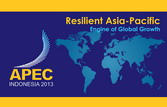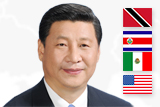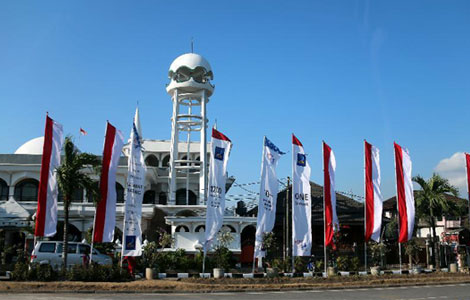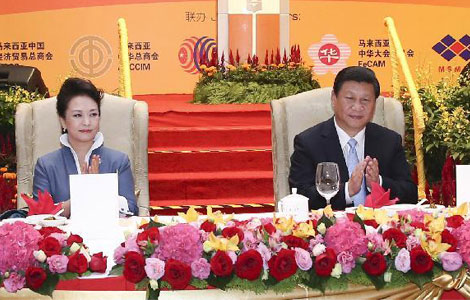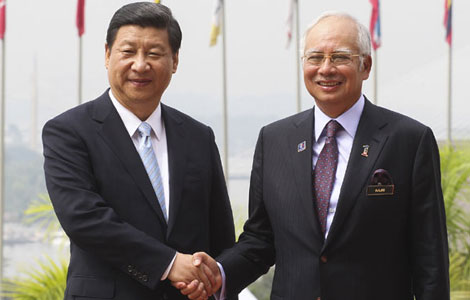TPP, RCEP, APEC to eventually converge
By ( Xinhua )
Updated: 2013-10-05
BALI, Indonesia - The different architecture of regional economic cooperation such as Trans-Pacific Partnership (TPP), the Regional Comprehensive Economic Partnership (RCEP) and APEC should have complementarity and eventually converge, said a scholar on Southeast Asian Studies. ?
In a recent interview with Xinhua, Sanchita Basu Das, a research fellow at the Singapore-based Institute of Southeast Asian Studies said that she still saw a niche for the Asia-Pacific Economic Cooperation (APEC) in trade facilitation as it brings together both political and private sector business leaders, and both the United States and China.
The diverse grouping of 21 economies in the Asia Pacific enables a constant dialogue between the stakeholders of the free trade process and the policy makers.
"At the end of the day, the main contribution of APEC is trade and investment facilitation," she said.
"I would say APEC is the best platform because that is the only thing that has both the business leaders and the political leaders together."
The Bogor Goals, which was endorsed by APEC leaders in 1994 and has since been an important guideline for the free trade process in the Asia Pacific, has three pillars, namely trade liberalization, trade and investment facilitation, and technical cooperation, particularly capacity building.
Sanchita said much has been achieved in trade liberalization, and the technical cooperation involves long-term efforts, leaving trade and investment facilitation the focus of the work that should be done by APEC.
According to statistics provided by the APEC Secretariat, the average tariffs in the APEC region dropped from about 17 percent in 1989 to 5.7 percent in 2011, though the tariffs in agriculture was higher at 11.9 percent.
The percentage of zero-tariff product lines went up to 45.2 percent in 2010, and the percentage of product lines with tariffs at 10 percent or above decreased to 14.7 percent.
It has been increasingly difficult to further reduce the tariffs, especially in the agricultural sector, though officials at the APEC Secretariat said that more can be done to further reduce the tariffs.
Sanchita said trade and investment facilitation, firstly, involves work on infrastructure, like building roads to reduce the time needed to transport the goods.
Secondly, it also involves streamlining the procedures and cutting red tape to reduce the time needed for documentation.
Nowadays the production of a single shirt, for example, may involve four economies. "If you don't streamline the procedures, you may have to file 40 documents each time it crosses a border. That's why we have the single-window mechanisms," she said.
The scholar also highlighted the non-tariff barriers such as export taxes or even export bans -- they may be used as an excuse to protect certain interests. Neither the free trade agreements nor the World Trade Organization address the issue.
There is no easy solution for such challenges but efforts can be made to specify some of the circumstances where certain actions are not allowed, she said.
Trade facilitation is important because the business community may not be able to fully use even the existing arrangements with lower or zero tariffs if the infrastructure is not there or if the efficiency of customs procedures is not guaranteed and therefore can be costly, she added.
"If you have perishable goods, it will be worrying. And if you have other goods, you will be worried about the delivery time," she said.
Even the WTO process may have to focus on trade facilitation as it will be difficult of break out of the deadlock of the Doha Round in the near future, she added.
Sanchita said the leaders and the negotiators involved in the different architectures of regional economic cooperation such as the TPP, the RCEP and APEC should talk to each other so as to ensure that they can get together eventually to lead to a free trade area of the Asia Pacific, though it is OK to have parallel tracks at the current stage.
"Instead of having a very competitive approach for these three different integration processes, you should be talking to each other, 'OK, what you are doing,' instead of repeating things, see how you can strengthen the things," she said.
"At the end of the day there should be some complementarity and there should be some convergence in future."
She said that the TPP and the RCEP will be the "main vehicles" of free trade processes for the time to come, but APEC should still have a niche of its own.
The TPP is largely a rules-based process driven by the United States, but some of the economies, including China, may not be ready to join the demanding free trade agreement yet.
The RCEP is also more rules-based compared with APEC. It is based on the many ASEAN+1 free trade arrangements involving its six dialogue partners, but it has more flexibility compared with the TPP, which will be very rules-based.
In this sense, these arrangements are complementary, Sanchita said.
APEC not only has all the different countries together, but also is relatively ahead of the other arrangements in terms of trade facilitation, she added.
The United States is not part of the RCEP, China is not part of the TPP, and Indonesia is not part of the TPP, either, but they are all part of the APEC.
Sanchita said China is expected to eventually join the TPP but it is waiting for the right moment and for an acceptable shape.
It may give a push to the APEC process to pursue where it will miss from not joining the TPP, but the convergence of the regional arrangements could be put on the agenda when it chairs the APEC Leaders' ?Meeting and set the themes for APEC next year.But both the TPP and the RCEP have yet to take a final shape.
"They can be complementary. It all depends on where they want to go," she said, referring to the three arrangements of the TPP, the RCEP and APEC.
Schedule
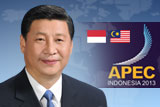
President Xi visits Indonesia, Malaysia, attend APEC summit
Oct 2 to 3: Pay State Visit to Indonesia
Oct 4 to 5: Pay State Visit to Malaysia
Oct 6 to 8: Attend the 21st economic leaders' meeting of APEC forum and meet with global leaders in Bali, Indonesia
Forum
Australia must wake up from the American Fantasy and start living the Chinese Dream. Australian culture is more in line with China than America.
China and ASEAN to handle territorial issues like friends
China and its neighbours should handle the issue of territorial claims as a problem between friends rather than a conflict with one another.

